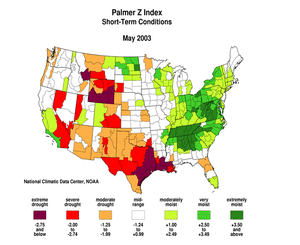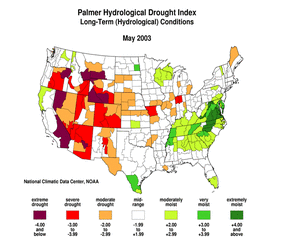U.S. Drought Highlights:
- On the national scale, severe to extreme drought affected about 14 percent of the contiguous United States as of the end of May 2003
- moderate to extreme drought affected about 22 percent of the contiguous U.S.
- Short-term conditions were dry across much of the southern Plains and parts of the West
- Above-normal precipitation fell over some of the drought areas of the West and Great Lakes
- Long-term moisture deficits persisted across parts of the Ohio Valley to central Plains, northern Maine, and much of the West
Please Note: The data presented in this drought report are preliminary. Ranks, anomalies, and percent areas may change as more complete data are received and processed.
National Overview
On the national scale,
- severe to extreme drought affected about 14 percent of the contiguous United States as of the end of May 2003, an increase of about 3 percent compared to last month
- about 22 percent of the contiguous U.S. fell in the moderate to extreme drought categories (based on the Palmer Drought Index) at the end of May
- on a broad scale, the last two decades were characterized by unusual wetness with short periods of extensive droughts, whereas the 1930s and 1950s were characterized by prolonged periods of extensive droughts with little wetness (see graph below right)
- about 3 percent of the contiguous U.S. fell in the severely to extremely wet categories at the end of May
- a file containing the national monthly percent area severely dry and wet from 1900 to present is available
- historical temperature, precipitation, and Palmer drought data from 1895 to present for climate divisions, states, and regions in the contiguous U.S. are available at the Climate Division: Temperature-Precipitation-Drought Data page in files having names that start with "drd964x" and ending with "txt" (without the quotes).
Regional Overview
Above-normal precipitation fell across some of the Great Lakes, northern Plains, and Far West drought areas during May 2003. However, other parts of the West and much of the southern Plains were very dry. The dryness stretched back across the spring months (March-May) for the southern Plains and much of the Southwest.
The primary stations in Hawaii were generally drier than normal during May, the last three months, and for the year to date. The precipitation pattern at the Alaska stations was mixed for the three periods. The primary stations in Puerto Rico were drier than normal during May but wetter than normal for the 3- and 5-month periods.
Some regional highlights:
- Texas had the second driest spring (March-May), sixth driest year-to-date, and ninth driest May
- the South region had the ninth driest spring (March-May) and seventh driest year-to-date
- even though the last two months have averaged wetter than normal for the East North Central region, long-term dryness has resulted in the 13th driest November-May
- according to the USDA, 40% or more of the early June pasture and range land, topsoils, and subsoils were classified in "poor" or "very poor" ("short" or "very short") condition for several southern and central Plains and western states
- national pasture and range land conditions for 2003 were running near the 1995-2002 average
- end-of-May reservoir storage for all but one of the western states averaged below the long-term mean percent of capacity for this time of year
- Long-term drought continued across much of the West, from the central Plains to the southern Great Lakes, and over parts of Maine
- Although unusually wet conditions for the last 9 months have ended drought in the Southeast U.S., precipitation deficits remained at the 36-month to 60-month timescales
 NOAA's National Centers for Environmental Information
NOAA's National Centers for Environmental Information

